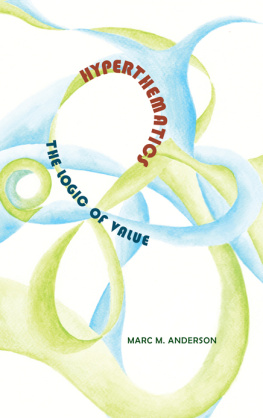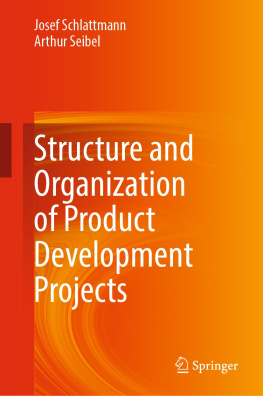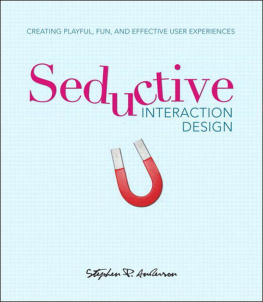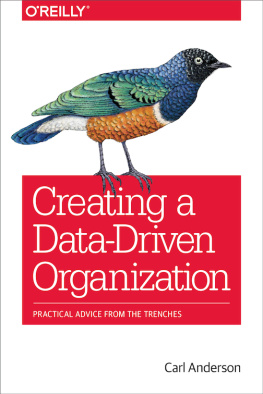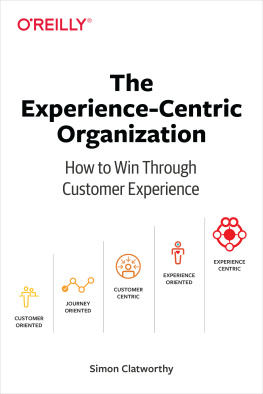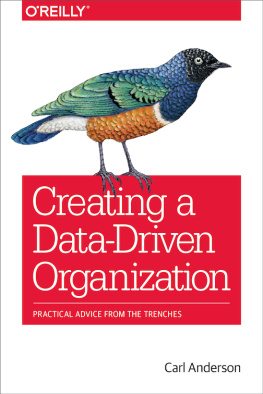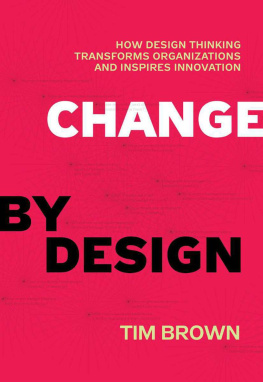Hyperthematics
SUNY series in American Philosophy and Cultural Thought
Randall E. Auxier and John R. Shook, editors
Hyperthematics
The Logic of Value
MARC M. ANDERSON
Cover art: Green and Blue at Play courtesy of Marc M. Anderson
Published by State University of New York Press, Albany
2019 State University of New York
All rights reserved
Printed in the United States of America
No part of this book may be used or reproduced in any manner whatsoever without written permission. No part of this book may be stored in a retrieval system or transmitted in any form or by any means including electronic, electrostatic, magnetic tape, mechanical, photocopying, recording, or otherwise without the prior permission in writing of the publisher.
For information, contact State University of New York Press, Albany, NY
www.sunypress.edu
Library of Congress Cataloging-in-Publication Data
Names: Anderson, Marc M., author.
Title: Hyperthematics : the logic of value / Marc M. Anderson.
Description: Albany : State University of New York, 2019. | Series: SUNY series in American philosophy and cultural thought | Includes bibliographical references and index.
Identifiers: LCCN 2018040463 | ISBN 9781438475332 (hardcover : alk. paper) | ISBN 9781438475356 (ebook)
Subjects: LCSH: Values.
Classification: LCC BD232 .A4825 2019 | DDC 121/.8dc23
LC record available at https://lccn.loc.gov/2018040463
10 9 8 7 6 5 4 3 2 1
To Beijia and Merengel
my two loves who interpret me
and
To my Beloved Teacher Josiah Royce
separated now in time but not in Spirit
Contents
by Randall Auxier
Part I
Mode of Expansive Exploration
Part II
Mode of Expansive Reconstruction
Acknowledgments
Two people in particular, both of whom I consider to be friend and mentor, have helped me in the creation of this work. Professor Andr Cloots of the Katholieke Universiteit Leuven, patiently and regularly read and offered suggestions to the first rough version. His constant support and encouragement, in response to my straying beyond the conventional bounds of research into the undiscovered country of creative construction, is the hallmark of a great teacher, and I thank him for the privilege of being his student. Professor Randall Auxier, whom I first met on a noisy train pushing through the Polish countryside, has been essential to the development of this work. He inhabits those regions where I am most at home philosophically. He was an explorer there before me and it was through his influence that I first came to realize that metaphysics was at the service of ethics in Royces philosophy. Without his ongoing effort in a multitude of practical ways, I could not have completed this work. He has my profound thanks.
I would like to thank the editorial team at SUNY Press also, and Andrew Kenyon, Rafael Chaiken, Chelsea Miller, and Diane Ganeles particularly, along with the patient and insightful reviewers of this work.
Most of all, I would like to thank my family: my ever faithful wife, Beijia, for her optimism and unwearying care over the many years of finishing this, and my son, Merengel, who constantly reminded me as I wrote, that the spirit of philosophy is really best expressed in those words of little children: can we play now Baba?
Foreword
I first met Marc Anderson ten years ago on a train that would take us from Berlin to Opole, which is a charming city in southern Poland. There we would discuss the philosophy of Josiah Royce for a week with a group of distinguished philosophers from around Europe and North America. I was fortunate to meet Marc early in the trip and since it was a long ride, we had an opportunity to discuss quite thoroughly what he was working on. He was then a PhD student at Katholieke Universiteit Leuven (Louvain), in Belgium. By the end of the week I was aware that I would be in discussion with Marc for the rest of my career. The overlap of interests combined with differing talents and perspectives meant that I would be able to learn from Marc as from few others.
At that time Marc had been studying Royces logic, as indeed I also do, and he had some interesting ideas about how to apply Royces most mature logical ideas, which is called System Sigma. Marc explains this connection in what follows, but what he will not say is how unusual it is for someone studying pure logics to become so deeply absorbed in practical applications. In my first conversation with him, Marc gave me an image that I have never forgotten, and I now offer it to you. You have seen the beauty of birds flocking and fish schooling. You have surely wondered How do they do that? Why dont they run into one another? What sort of communication is this? Such is our common wonder at such a sight. Yet, have you ever paused to consider not just the visible forms and movement, but the logical and mathematical structure of what you are witnessing?
Process philosophers hold that this sort of order is abstracted from our experience. It is not that the logical order and mathematical order explains what we see; it is the other way around. What we see is what is , and what is explains whatever we learn from that starting place. It is not that we know the math or logic and then explain the flocking and schooling; it is that the flocking and schooling occurs and from that we learn the math and the logic. But here is the catch. We havent gotten very far with the forms of order implicit in flocking and schooling. The mathematical and logical order of living systems and ecological relations is enormously complex. We are only beginning to puzzle it out. But what is important is that as we discover the forms of living order, we begin to see that many social behaviors, both of humans and nonhuman animals, actually exhibit tremendous commonality and continuity with the logic and mathematics we are discerning in the activity of complex systems.
I visited with Marc again in 2011 when we met in Indianapolis at a gathering of the Midwest Pragmatism Study Group. In the three intervening years Marc had finished his dissertation project and returned to Canada. I read this work and followed closely his development of ideas from Whitehead and Royce. The historical work he undertook to give these two figures a close reading will, I am sure, eventually be published as a scholarly book. But the conversations in Indianapolis led us to collaborate in a study of the structures of intensive logics. We began looking at C. I. Lewiss A Survey of Symbolic Logic (1917). Lewis was Royces star student studying symbolic logic, and this book was essentially his dissertation, reworked. We sought to connect Royces System Sigma to its grounding in classical and intensive logics, for the sake of a more thorough understanding of his thinking. Royce left behind thousands of pages of scattered logical writings, beginning very early in his life (his undergraduate notebooks from Berkeley have the earliest existing records), and extending until his very last days. These unorganized piles of thinking may contain amazing breakthroughs, but our aim was to try to follow the thread of his thinking so that we could mine these materials for whatever they may contain. Lewiss dissertation and early papers represented a fine mind engaged with this work at the very end of Royces life.
Our logic research group consisted of Marc, me, and about five other people, in the beginning. The membership rotated through another seven or eight people over the next six years, as graduate students left and advanced undergraduate students became graduate students elsewhere. Marc and I were the only members during the entire run, although Gary L. Herstein was there during most of that time. Marc was refining the manuscript for the present book during this time, and he was bouncing ideas off the group. I think it is fair to say that this group was crucial to the final form of the present book, but the reader may benefit from just a bit more of the background. This book is highly creative, unlike anything published before, and it may not be easy for readers to grasp what is happening or how to classify what is being learned. Is this logic? (Yes.) Is it aesthetics? (Yes.) Is it applied ethics? (Yes.) Is it normative ethics? (Yes.) Is it moral philosophy? (Yes.) Is it social philosophy? (Yes.) Is it epistemology? (Yes.) Is it metaphysics? (Yes.) Perhaps one begins to see the problem.

